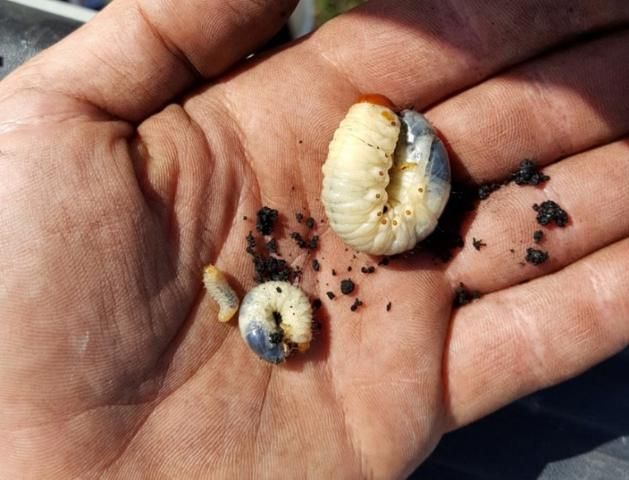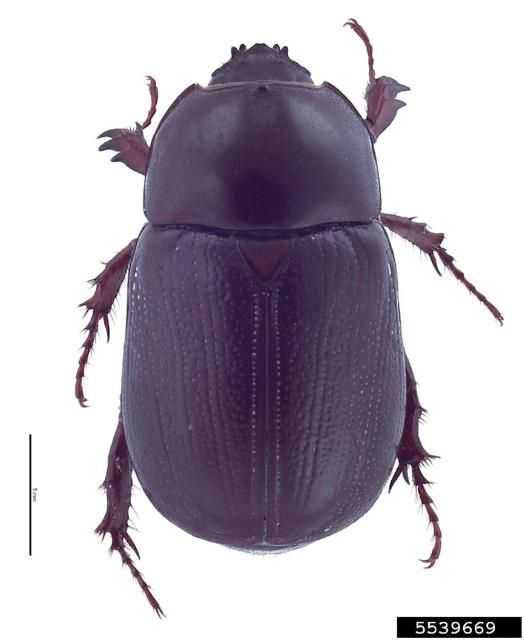Soil insects are economically important pests for Florida sugarcane growers in the Everglades Agricultural Area (EAA). This publication presents surveys of these pests from 2015 and 2016, compares them to several historical surveys, and examines the association of soil parameters (acidity, calcium, magnesium, and silicon content, and depth) with the abundance of the pests. The intent of this document is to inform sugarcane growers, scouts, pesticide applicators, and researchers on fluctuations of economically important pests with implications on their management.
Wireworms
Historically, wireworms (Coleoptera: Elateridae) were the first soil insects surveyed causing significant damage in Florida sugarcane (Bregger et al. 1959). Hall (1988) reported twelve species of wireworms in the crop. Past surveys have shown that Melanotus communis (Gyllenhal) is the species causing the most economic damage (Figures 1 and 2).

Credit: Mike Karounos, UF/IFAS

Credit: Mike Karounos, UF/IFAS
Abundance of soil insect pests from 20 commercial sugarcane fields (sampled 2015 and 2016) is shown in Table 1. Insects were collected from intact sugarcane stools by hand. Sampling was done post-harvest for easier access to fields. For more detailed methods on survey sampling, see Cherry et al. (2017), Changes in the Relative Abundance of Soil-Dwelling Insect Pests in Sugarcane Grown in Florida, on which this publication was based (https://doi.org/10.18474/JES16-33.1).
In our survey, M. communis, was clearly the dominant wireworm species (88%). This has been the most important wireworm species in Florida sugarcane for a long time (Hall 1988). The species was added to the EPPO A1 action list of quarantine pests in 2002 (OEPP/EPPO 2005).
White Grubs
The second group of soil insect pests reported causing significant damage in Florida sugarcane historically were white grubs (Coleoptera: Scarabaeidae) (Figure 3).

Credit: Mike Karounos, UF/IFAS
Gordon and Anderson (1981) reported on significant grub damage first observed in 1971. Six species were associated with the crop, with Tomarus subtropicus (Blatchley) causing the most economic damage. In 1988, Cherry found that T. subtropicus was the largest and most abundant grub. In 1994, Stansly et al. determined T. subtropicus was 23% of all grubs found in muck soils.
In recent years, however, R. H. Cherry has observed what appears to be a major change in the relative abundance of soil insect pests, especially scarabs, in Florida sugarcane.
In our 2015 and 2016 surveys, we observed four of the six scarab grub species ranging from 20% to 30% in relative abundance. Cyclocephala parallela Casey and Phyllophaga latifrons (LeConte) are occasional pests of Florida sugarcane; Anomala marginata (F.) and Dycinetus morator (F.) are not. Gordon and Anderson (1981) reported Euphoria sepuchralis (F.) to be associated with Florida sugarcane although not causing damage. We did not find this latter species in any of our samples. Of special interest are our findings with T. subtropicus (Figures 4 and 5).

Credit: Mike Karounos, UF/IFAS

Credit: Emmy Engasser, Hawaiian Scarab ID, USDA APHIS PPQ, Bugwood.org
Our study was conducted using methods similar to the historical surveys. However, despite sampling more fields, we found no T. subtropicus in our 2015 and 2016 surveys. This is consistent with R. H. Cherry's observation that no incidences of grub damage in Florida sugarcane have been reported during the last ca. 20 years while working in the heart of Florida sugarcane. Hence, what was once the most important soil insect pest of Florida sugarcane has essentially disappeared from sugarcane fields, ceasing to be a problem. What exactly caused this major shift is unknown.
Root Weevil
Diaprepes root weevil (Curculionidae), Diaprepes abbreviatus (L.), is an important pest of sugarcane and citrus in various islands of the Caribbean. It has long been a pest in Florida citrus. In 2010, infestations of the weevil were observed causing damage to Florida sugarcane for the first time (Cherry et al. 2011) (Figure 6).

Credit: Ron Cherry, UF/IFAS
The only weevil (Coleoptera: Curculionidae) species found in the 2015 and 2016 surveys was D. abbreviatus. However, only 13 larvae were found in all samples from 20 fields. This would indicate the insect has not become a serious pest in Florida sugarcane.
Survey Summary
No new unknown soil insect pests were found in the 2015 and 2016 surveys. Very few sugarcane root weevils were found. This shows that in Florida sugarcane, this pest is still uncommon. The once important grub pest, T. subtropicus, was not even detected in fields. Finally, wireworms and especially grubs found in fields were positively correlated with muck soil depth (Figure 7 and Table 2).

Credit: UF/IFAS
Two factors have increased flooding, which is effective in reducing soil insect populations, in the Everglades Agricultural Area (EAA). (See "Management by Flooding," below.) Best management practices (BMP) including water held during the rainy season to reduce phosphorous discharge is the first factor. Second is organic matter oxidation due to the drainage of organic (muck) soils. This has led to the prevalence of shallow soils in the EAA, and these shallow soils are frequently flooded (Jennewein et al. 2016). This phenomenon of soil subsidence has been documented and researched by soil and water scientists at the Everglades Research and Education Center for decades (Figure 8).

Credit: Mike Karounos, UF/IFAS
Management by Flooding
There are more publications on flooding for soil insect control for southern Florida than for anywhere else in the world. Flooding either fallow fields or by rotation with rice cultivation is a part of best management practices in the EAA and is recommended in many other UF/IFAS publications for sugarcane soil insect IPM. Flooding can kill soil insects directly by drowning them, or it can kill them indirectly by exposing them to predation, often by diverse and abundant birds (Figure 9).

Credit: Mike Karounos, UF/IFAS
Wireworms in Florida sugarcane are more flood tolerant than grubs (Hall and Cherry 1993). Among grubs tested in the EAA, T. subtropicus is the least flood tolerant, which may partially explain its disappearance (Cherry et al. 1990).
For wireworms, flooding during late spring and summer will kill the wireworms and prevent egg-laying by the adult click beetles. Thus, flooding fallow fields or growing flooded rice as a rotational crop reduces wireworm infestations. Flooding can be effective if it is maintained continuously for a minimum of six weeks during the summer. Longer flooding periods are needed during colder months.
Short-term flooding for grubs is most efficient in August, when water temperatures are warm, rainfall is abundant, and grubs initiate feeding. Discing infested fields and decreasing the number of ratoon crops also reduce white grub infestations (Beuzelin et al. 2022).
For further information, please see Cherry, McCray, and Sandhu (2017), from which this publication was adapted.
References
Beuzelin, J. M., R. H. Cherry, G. S. Nuessly, and H. S. Sandhu. 2022. Insect Management in Sugarcane. ENY-406 Gainesville: University of Florida Institute of Food and Agricultural Sciences. https://edis.ifas.ufl.edu/ig065
Bhadha, J. H., A. L. Wright, and G. H. Snyder. 2020. Everglades Agricultural Area Soil Subsidence and Sustainability. SL-311. Gainesville: University of Florida Institute of Food and Agricultural Sciences. https://edis.ifas.ufl.edu/ss523
Bregger, T., P. Dunckelman, F. LeGrand, E. Todd, and D. Questel. 1959. "A Brief Review of Sugarcane Research in Florida, 1939–1959." Annual Proceedings of the Soil and Crop Science Society of Florida 19:287–294.
Buss, E. A. 2018. Sugarcane Grub, Tomarus subtropicus Blatchley (Insecta: Coleoptera: Scarabaeidae). EENY318. Gainesville: University of Florida Institute of Food and Agricultural Sciences. https://edis.ifas.ufl.edu/in593
Cherry, R. 1988. "Correlation of Crop Age with Populations of Soil Insect Pests in Florida Sugarcane." Journal of Agricultural Entomology 4:241–245.
Cherry, R., F. Coale, and P. Porter. 1990. "Oviposition and Survivorship of Sugarcane Grub (Coleoptera: Scarabaeidae) at Different Soil Moistures." Journal of Economic Entomology 83:1355–1359.
Cherry, R., D. Hall, A. Wilson, and L. Baucum. 2011. "First Report of Damage by the Sugarcane Root Weevil Diaprepes abbreviatus (Coleoptera: Curculionidae) to Florida Sugarcane." Florida Entomologist 94:1063–1065.
Cherry, R., M. McCray, and H. Sandhu. 2017. "Changes in the Relative Abundance of Soil-Dwelling Insect Pests in Sugarcane Grown in Florida." Journal of Entomological Sciences 52 (2): 169–176. https://doi.org/10.18474/JES16-33.1
Cherry, R., and P. Stansly. 2008. "Abundance and Spatial Distribution of Wireworms (Coleoptera: Elateridae) in Florida Sugarcane Fields on Muck versus Sandy Soils." Florida Entomologist 91:383–387.
Daroub, S. H., T. A. Lang, O. A. Diaz, and M. Chen. 2018. Best Management Practices in the Everglades Agricultural Area: Controlling Particulate Phosphorus and Canal Sediments. SL228. Gainesville: University of Florida Institute of Food and Agricultural Sciences. https://edis.ifas.ufl.edu/ss448
Gill, H. K., G. Chahil, G. Goyal, J. L. Gillett-Kaufman, and R. Cherry. 2024. "Corn wireworm Melanotus communis Gyllenhal (Insecta: Coleoptera: Elateridae)." EENY584. Gainesville: University of Florida Institute of Food and Agricultural Sciences. https://edis.ifas.ufl.edu/in1025
Gordon, R., and D. Anderson. 1981. "The Species of Scarabaeidae (Coleoptera) Associated with Sugarcane in South Florida." Florida Entomologist 64:119–138.
Hall, D. 1988. "Insects and Mites Associated with Sugarcane in Florida." Florida Entomologist 71:138–150.
Hall, D., and R. Cherry. 1993. "Effect of Temperature on Flooding to Control the Wireworm Melanotus communis (Coleoptera: Elateridae)." Florida Entomologist 76:155–160.
Jennewein, S., S. Daroub, J. Bhadha, T. Lang, M. Singh, and M. McCray. 2016. "Managing Shallow Organic Soils to Maximize Sugarcane Yield in the Everglades Agricultural Area." Sugar Journal 79:22.
McCray, J. M., H. S. Sandhu, R. W. Rice, and D. C. Odero. 2019. Nutrient Requirements for Sugarcane Production on Florida Muck Soils. SS-AGR-226. Gainesville: University of Florida Institute of Food and Agricultural Sciences. https://edis.ifas.ufl.edu/sc026
OEPP/EPPO. Melanotus communis. 2005. Data sheets on quarantine pests. Bull. 35:380–382.
Stansly, P., R. Cherry and O. Sosa, Jr. 1994. "Relative Abundance of White Grubs (Coleoptera: Scarabaeidae) in Florida Sugarcane on Sand and Muck Soils." Journal of the American Society of Sugar Cane Technologists 14:19–24.
Weissling, T. J., J. E. Peña, R. M. Giblin-Davis, and J. L. Knapp, Jr. 2019. Diaprepes Root Weevil, Diaprepes abbreviatus (Linnaeus) (Insecta: Coleoptera: Curculionidae). EENY-024. Gainesville: University of Florida Institute of Food and Agricultural Sciences. https://edis.ifas.ufl.edu/in151